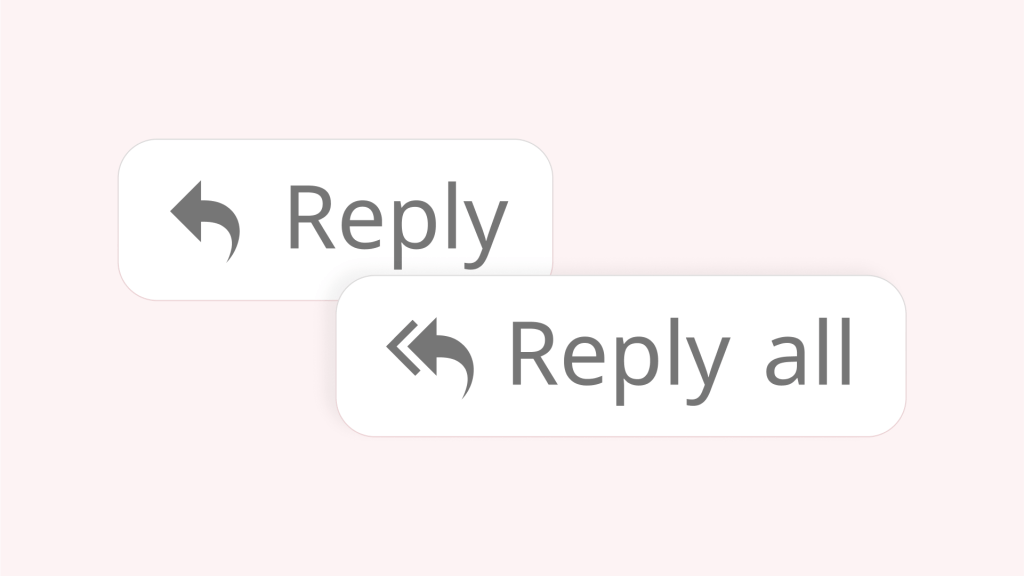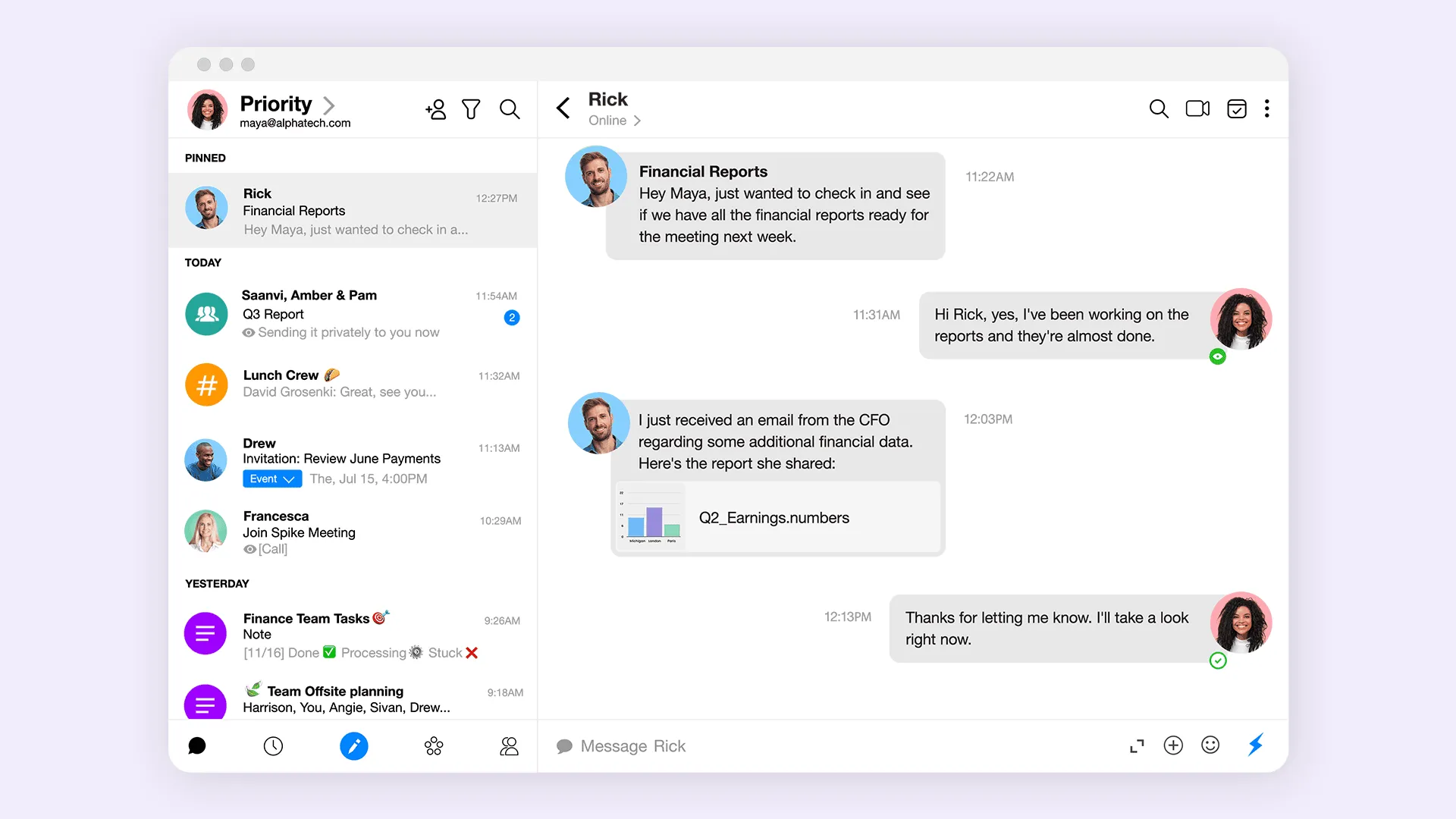How conversational design fixes the "reply-all" email storm

You know the feeling. Your phone buzzes incessantly as notification after notification floods in from a reply-all chain gone wild. Colleagues frantically hitting “reply all” to ask others to stop hitting “reply all.”
Important context buried somewhere in an endless thread that no one wants to read through. The original sender sitting in embarrassed horror, watching their simple question trigger an organizational meltdown.
Reply-all storms aren’t communication failures, they’re design failures. Traditional email wasn’t built for group conversation, yet we keep forcing it to work that way. The result is predictable chaos that conversational design principles can eliminate entirely.
Why reply-all storms happen
Every email storm follows the same destructive pattern. Someone sends what seems like a straightforward group email. Recipients panic about responding to everyone versus just the sender. Half choose wrong, others respond to correct the responders, the thread fragments into parallel conversations while notifications multiply exponentially.
The fundamental problem isn’t user behavior, it’s that traditional email forces artificial decisions about group communication at exactly the wrong moment.
When you receive a group email, you face an impossible choice:
- respond to everyone (potentially irrelevant)
- respond privately (potentially excluding stakeholders).
This decision happens under time pressure with incomplete information about who actually needs your response.
Reply-all storms happen because email makes natural group communication artificially complex.
Consider the facilities manager who emails the marketing team about conference room availability. It seems simple enough, but the thread spirals as people discuss scheduling conflicts, debate meeting policies, share unrelated calendar issues, and eventually argue about reply-all etiquette itself. Three hours later, nobody remembers the original question about room availability.
The TO/CC/BCC structure creates false boundaries around natural conversation flow. Real discussions evolve organically. People become relevant as topics develop, while others lose interest as conversations shift direction. Traditional email requires predicting these changes before they happen.
Threading compounds the problem by creating visual chaos. Traditional email displays every response as a separate message with its own subject line and timestamp. Following conversation evolution requires mental effort that scales badly with group size.
Reply-all anxiety is real and rational. A single misplaced click can expose sensitive information to dozens of unintended recipients. Personal comments meant for trusted colleagues suddenly reach professional acquaintances. Confidential information spreads beyond its intended boundaries.
The notification cascade effect
Simple miscommunications become organizational crises because of how notification systems amplify every message. Traditional email treats all messages equally, whether they contain substantive contributions or requests to be removed from the thread.
Your phone buzzes for the project update. It buzzes again for someone asking “why am I on this thread?” It buzzes a third time for someone responding “please remove me too.” Each buzz fragments your attention while the actual signal gets buried deeper in the noise.
The psychological impact compounds across the organization. People develop defensive communication patterns to avoid triggering storms. They over-explain to prevent misunderstanding. They copy extra recipients to avoid exclusion accusations. Each defensive action generates more email volume and complexity.
Workplace communication research reveals that reply-all incidents increase email volume significantly, or create organizational disasters.
Conversational design principles
Conversational design operates from a simple premise: digital communication should feel as natural as speaking with someone face-to-face.
When you talk with colleagues in person, you don’t announce your intended audience beforehand, and you don’t structure every comment formally. Natural conversation flows organically as participants join, contribute, and leave based on interest and relevance. Boundaries around who hears what develop naturally rather than through technical management.
Conversational design eliminates artificial communication decisions by making the interface match natural interaction patterns. Instead of managing recipients, you participate in ongoing discussions. Instead of predicting future relevance, you engage with current context.
The interface psychology shift
Traditional email interfaces signal formality through visual design choices that create psychological barriers to natural communication. The TO/FROM/SUBJECT structure suggests document creation rather than conversation participation. Reply buttons force binary choices that don’t exist in natural group interaction.
Conversational interfaces use visual cues that signal informal, ongoing discussion. Messages appear in chronological flow without artificial separation. Participant lists stay visible and adjustable. The interface suggests “join the conversation” rather than “compose a document.”
This psychological shift eliminates the decision paralysis that creates reply-all confusion. When the interface looks like natural conversation, people communicate naturally rather than strategically.
Visual design matters enormously. Conversational interfaces look like messaging apps rather than formal documents. Messages flow chronologically without artificial threading complexity. Participant visibility stays natural and adjustable rather than technically managed.
Context preservation happens automatically. Related messages stay connected regardless of topic evolution. History remains accessible without requiring manual organization. Brief responses feel appropriate because shared context provides necessary background.
The network effect advantage
Conversational design benefits multiply when entire teams adopt the approach. Reply-all storms require critical mass to become destructive. When communication tools prevent the cascade effect, isolated incidents remain isolated.
Organizations using conversational email report that reply-all incidents decrease by over 90% within the first month of adoption. More importantly, the fear of causing storms disappears, which enables more open and collaborative communication patterns.
How Spike embodies conversational design

Spike demonstrates conversational design principles through specific interface choices that eliminate reply-all complexity entirely.
- Natural threading groups conversations by participants rather than subject lines. Related discussions stay connected even when topics evolve, which eliminates the recipient management decisions that create reply-all confusion.
- Default continuity assumes ongoing conversations involve the same participants unless you deliberately change them. This eliminates the choice paralysis between reply and reply-all while allowing natural conversation evolution.
- Visual participant management makes conversation membership transparent and easily adjustable. You see who’s involved and can modify participation naturally rather than managing hidden recipient lists.
- Conversation flow displays messages chronologically in a chat-like interface that makes following discussion evolution effortless. No more archaeological work through fragmented email threads to understand current context.
The interface handles the technical complexity of group communication automatically while preserving the social dynamics that make collaboration effective. Participants focus on contributing value rather than managing email mechanics.
Teams using Spike report dramatically reduced reply-all incidents because the interface makes appropriate communication feel natural rather than requiring technical decisions. Decision-making accelerates when conversations flow without distribution overhead.
Information sharing improves when relevant context stays accessible without flooding irrelevant participants.
Beyond the storm
Reply-all storms will disappear as communication tools evolve to match natural interaction patterns. The problem isn’t human behavior around group communication, it’s interface design that fights against natural communication instincts.
Conversational design represents the future of business communication because it eliminates artificial complexity while preserving the collaboration benefits that make group communication valuable.
The goal isn’t better reply-all etiquette. It’s communication tools that make reply-all storms impossible by designing group interaction naturally from the beginning.
Ready to eliminate reply-all storms entirely?
Spike’s conversational design transforms group email from technical challenge into natural collaboration. Experience communication that flows like conversation, not email management.




